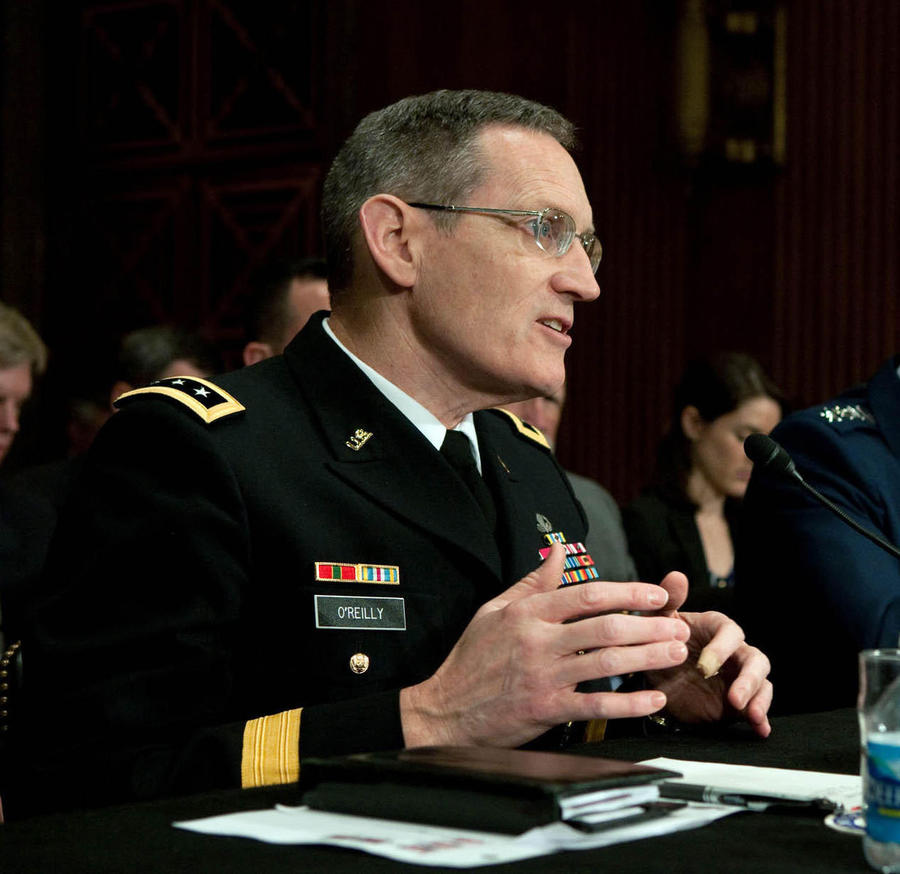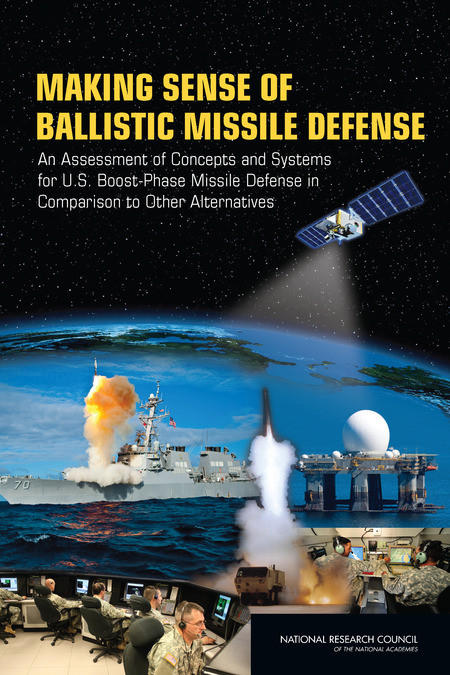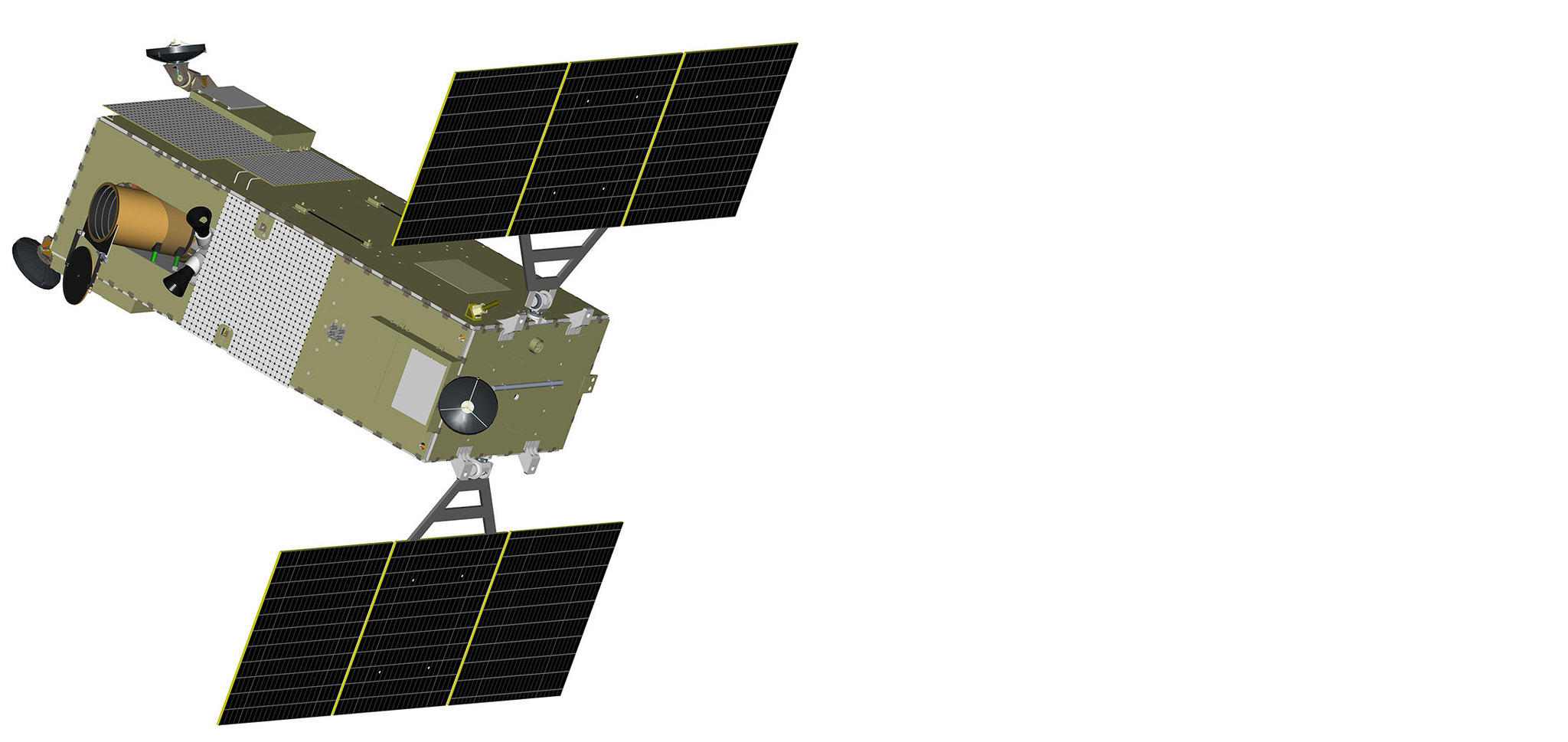Proponents of the Precision Tracking Space System were not shy about touting its supposed benefits.
The head of the U.S. Missile Defense Agency said PTSS represented an “unprecedented capability” to protect America and its allies against a nuclear attack by the likes of North Korea and Iran.
A key congressional supporter described it as “a necessity for our country.”
The planned network of nine to 12 satellites, orbiting high above the equator, would detect missile launches and track warheads in flight with great precision, the proponents said.
It would be able to tell apart real missiles from decoys — an elusive capability known as “discrimination.” It would help guide U.S. rocket-interceptors to destroy incoming warheads. And it would do all this at a fraction of the cost of alternative approaches.
Based on those promises, the Obama administration and Congress poured more than $230 million into design and engineering work on PTSS starting in 2009. Four years later, the government quietly killed the program before a single satellite was launched.
The Missile Defense Agency said PTSS fell victim to budget constraints. In fact, the program was spiked after outside experts determined that the entire concept was hopelessly flawed and the claims made by its advocates were erroneous. It was the latest in a string of expensive failures for the missile agency.
The Los Angeles Times examined hundreds of pages of congressional testimony and other government records and interviewed leading defense scientists and others familiar with PTSS.
Among the findings:
- In their equatorial orbit, the satellites would have been blind to warheads flying over the Arctic — one of the likely paths for missiles launched from Iran or North Korea.
- With at most 12 satellites, the system could not have provided continuous tracking of missiles across the Northern Hemisphere, as promised. That would require at least twice as many satellites.
- PTSS could not have reliably distinguished warheads from decoys and harmless debris. The satellites’ sensors were not powerful enough.
- The Missile Defense Agency’s cost estimate — $10 billion over 20 years — was way off. PTSS would have cost at least $24 billion over that time period, according to an independent assessment done for the Pentagon and Congress.
- Even if the system lived up to its billing, it would have been largely redundant. Existing satellites and radars can do much of what PTSS was supposed to do.
“It’s an example of what can go wrong in defense procurement: Huge amounts of money just pissed away on things that should never have advanced beyond a study,” said David K. Barton, a physicist and radar engineer who served on a National Academy of Sciences panel that reviewed U.S. missile-defense programs, including PTSS.
Philip E. Coyle III, former director of operational testing and evaluation for the Pentagon, said the PTSS fiasco could have been avoided if the concept had been properly vetted at the beginning.
“You could have done it on a napkin,” he said. “All you had to do was put pencil to paper.”
The push to enhance U.S. missile defenses was prompted by fears that North Korea, Iran or other “rogue” states might strike the U.S. with weapons of mass destruction.
The nation’s defense against a massive nuclear attack by Russia or China was — and still is — based on the Cold War doctrine of “mutually assured destruction”: the idea that no superpower would strike first, for fear of suffering a devastating counterattack.
Defense hawks argued that North Korea and Iran were less stable and predictable, and that the threat they posed required a different kind of response: a homeland defense system capable of destroying missiles in flight.
In 2002, President George W. Bush called for speedy deployment of such a missile shield. Prototypes had been in development since the Clinton administration.
The Ground-based Midcourse Defense system was rushed into the field and made operational in 2004. It consists of rocket-interceptors based at Vandenberg Air Force Base in Santa Barbara County, Calif., and Ft. Greely, Alaska.
Other systems overseen by the Missile Defense Agency protect Navy vessels and American troops abroad.
To foil an attack, all of the systems would rely on real-time information about missile launches and the location, speed and trajectory of incoming warheads. The data would come from existing military satellites and powerful radars based on land and at sea.
The satellites use infrared sensors to detect the fiery plume from missile launches. But they cannot follow a warhead once it has separated from its launch rocket and left the Earth’s atmosphere; the heat signature is too faint.
That is where radars come in. They can track the path of warheads after separation. Their reach, however, is limited by the Earth’s curvature, leaving gaps in radar coverage.
PTSS was presented as an answer to these challenges, and as a way to safeguard the United States and strengthen “regional defense” — the protection of allies and American forces overseas.
The system’s advocates included top officials in the Missile Defense Agency and in the office of the Secretary of Defense, as well as lobbyists for Northrop Grumman Corp., which was assisting with the engineering work.
These proponents said PTSS, from its vantage in space, would be able to track the complete trajectories of enemy missiles from launch to detonation, or “birth to death.”
Its advanced infrared sensors, they said, would pick up both launches and the extremely faint, long-wave radiation given off by warheads after separation.
Those same sensors were said to be capable of “discrimination,” even at vast distances — differentiating missiles from decoys, chunks of spent rocket fuel and other detritus.
With PTSS standing watch, the advocates said, the military would not have to build and install more radars, an expensive and tricky proposition, because some would have to be based on foreign soil.

In the spring of 2010, Lt. Gen. Patrick J. O’Reilly, then director of the Missile Defense Agency, went to Capitol Hill to secure support for the program.
O’Reilly, trained as a physicist, did not automatically plump for new projects. Previously, he had challenged missile-defense initiatives that he considered ill-conceived, angering members of Congress whose states or districts benefited from the spending.
But O’Reilly voiced no reservations about PTSS. The system would be able to “track hundreds of missiles being launched over their entire flight,” and its “very simple” engineering approach would keep costs down, he told Congress.
The agency was working with the Air Force, the Naval Research Laboratory and the Johns Hopkins University Applied Physics Laboratory in Laurel, Md.
Northrop Grumman and other industry giants — Boeing Co., Lockheed Martin and Raytheon Co. — would later be hired to do preliminary engineering work on PTSS. This positioned them to compete for the system’s prime manufacturing contract, worth hundreds and possibly thousands of jobs.
In remarks to congressional panels in the spring of 2011, O’Reilly said PTSS would help provide “advanced discrimination’’ for the defense of the United States and its allies.
He also emphasized the system’s affordability, telling a Senate panel on May 25, 2011, that “PTSS will provide three to six times the simultaneous tracking ability at a small fraction of the high operations costs” of new land or sea-based radars.
Republicans on the House Armed Services Committee, usually reliable supporters of missile defense spending, were unconvinced. They questioned whether the agency could deliver PTSS on schedule and whether the money might be better spent on other programs.
They recommended against including any funds for PTSS in that year’s defense authorization bill.

O’Reilly and Rep. C.A. Dutch Ruppersberger (D-Md.) pushed back.
“I believe that eliminating funding for the PTSS is the wrong course of action,” Ruppersberger told fellow members of a House Armed Services subcommittee on May 5, 2011.
The congressman did not have to spell out for colleagues the importance of PTSS to his home state of Maryland, where the Johns Hopkins lab was leading the design and engineering work.
Ruppersberger introduced a new rationale for PTSS, saying the system would improve the nation’s “space situational awareness” and counter China’s ambitions in space.
“We must support funding for the research and development of technologies that will enable us to protect the security of our country,” Ruppersberger said, “and allow our research labs, universities and private companies to do what they do best — innovate.”
Northrop Grumman lobbyists joined the drive to secure funding, according to interviews and lobbying disclosures filed with Congress. (A spokeswoman said the company would have no comment for this article.)
Supporters of PTSS carried the day. Democrats, who controlled the Senate, argued that the program held promise, and a Senate-House conference committee restored about half the $160 million that the Obama administration had requested for the 2012 fiscal year.
The first satellite was to be launched as early as 2015.
The panel of experts assembled by the National Academy of Sciences included eminent figures in the fields of aerospace and missile defense.
Eugene E. Habiger was a retired four-star Air Force general who had led the U.S. Strategic Command. David L. Fried was an authority on infrared detection. Melvin H. Eisman of the Rand Corp. in Santa Monica had deep expertise in estimating the costs of space-based missions.
The group’s leader was L. David Montague, a former president of missile systems for Lockheed Corp. who had overseen the production of thousands of ballistic missiles during the Cold War.
The academy had appointed the 16-member panel at the request of the Defense Department after Congress ordered an independent review of the nation’s ballistic missile defenses.
At their third meeting, held at the academy’s Washington headquarters in March 2010, the members took note of a new program called PTSS.
Missile Defense Agency officials told the panel that the system would do “great things,” Montague recalled. It would be capable of “birth to death tracking” and discrimination.
The latter capability was especially important, because the nation’s limited arsenal of ground-based interceptors — 4 at Vandenberg Air Force Base and 26 at Ft. Greely — would be exhausted quickly if they were mistakenly fired at decoys.
After hearing the enthusiastic descriptions of PTSS, Montague had a question:
“Tell us what the orbit configurations are.”
Informed that the satellites would orbit 932 miles above the equator, the panelists were immediately concerned.
Earth’s curvature limits the line of sight of satellites as well as radar — so PTSS would have difficulty tracking missiles in northerly latitudes. Iran and North Korea lie 35 degrees to 40 degrees north of the equator.
Northbound missiles launched from those countries would vanish as they approached the Arctic region, the panelists determined.
“The threat would disappear over the horizon,” Montague said in an interview. “There was this hole in the doughnut over the Polar region. You wouldn’t see them there.”
To track missiles continuously throughout the Northern Hemisphere, at least 24 satellites would be needed, with some in orbits well north of the equator.
The panelists further concluded that, given their equatorial position and the limits of their infrared sensors, the PTSS satellites could not be relied on to discriminate. They would be too far away from their targets to distinguish warheads from decoys.
And PTSS’ ability to detect launches was superfluous. Existing satellites could do that.
Panel members also concluded, based on Eisman’s analysis, that the missile agency had drastically understated the cost of the system.
A memo the agency sent to the Senate Armed Services Committee estimated the cost at $10 billion for the first 20 years. But that did not include the full expense of launching the satellites or operating the system, the independent experts determined.
They put the actual cost at $24 billion to $28 billion, depending on whether nine or 12 satellites were deployed.
For a much lower pricetag, about $9 billion over 20 years, a handful of powerful new radars on land could close the gaps in missile tracking and perform discrimination, the panelists found.
“The committee was absolutely in favor of missile defense,” recalled co-chairman Walter B. Slocombe, a former undersecretary of defense. “But there’s no point in building a system that doesn’t work.”
By the fall of 2011, the academy experts had completed a classified draft of their report. Before sharing it with congressional leaders and Pentagon brass, Montague briefed O’Reilly and a dozen of his subordinates in the director’s conference room at Missile Defense Agency headquarters at Fort Belvoir, Va.
Montague said he told O’Reilly: “We cannot see the rationale for PTSS. We believe it has a life-cycle cost of $24 billion to $28 billion. … And it will not do anything new or unique.’’
“Those aren’t our numbers,” an agency engineer countered.
“That’s right,” Montague said he replied. “We believe it should be canceled.”

A draft of the panel’s 282-page report, “Making Sense of Ballistic Missile Defense,” was circulated to policymakers before the next round of congressional budget hearings in the spring of 2012.
One section dealt with PTSS, and the conclusions were unsparing:
- “PTSS appears to be a solution looking for a problem.”
- “The rationale for PTSS was never explained to the committee in any coherent way.”
- The system would be “very expensive compared to other alternatives.”
In a letter to congressional leaders, Montague and Slocombe said: “The committee finds no valid justification for pursuing PTSS, and recommends terminating all effort on it.”
Supporters of PTSS would not go down without a fight.
O’Reilly was back on Capitol Hill on March 6, 2012, telling a House Armed Services subcommittee that the system “will provide unprecedented capability to track … ballistic missiles of all ranges throughout their entire flight.”
He said PTSS “will have some discrimination capability at deployment” and would help “provide effective and adaptable missile defense for our homeland.”
Ruppersberger called the system “a necessity for our country — especially so we’re not outgunned by the Irans, the [North] Koreas, the rogue states.”

Bradley H. Roberts, then deputy assistant secretary of defense for nuclear and missile defense policy, was on hand to defend PTSS. Ruppersberger asked him to describe “the consequences to our national security” if it were scuttled.
“We’d lose the assurance that we would always have the ability to track missiles, no matter where they’re launched in the Northern Hemisphere,” Roberts replied.
O’Reilly concluded the advocates’ case the following month, telling a Senate appropriations panel that PTSS offered “the greatest future enhancement for both homeland and regional defense in the next 10 years.”
Congress provided another round of annual funding. But the Obama administration soon gave up on the program. Obama’s next budget requested no money for PTSS, and it was officially “discontinued” on Oct. 1, 2013.
O’Reilly, who had retired by then, did not respond to messages seeking comment for this article. Nor did Ruppersberger.
Reacting to the National Academy report, the Defense Department’s Office of Cost Assessment and Program Evaluation did its own study of PTSS. It, too, found that the program would be redundant and would cost significantly more than the missile agency’s estimate, according to officials familiar with the still-confidential study.
All told, the government spent $231 million on PTSS, mainly on preliminary design and engineering, according to Cristina Chaplain, a senior analyst with the Government Accountability Office.
The Missile Defense Agency, in a statement to The Times, defended the investment and said the academy panel “did not recognize the benefits” the system would have brought, notably its hoped-for advantages over radar.
On the crucial issue of discrimination, the statement conceded that PTSS would have had only a “limited” ability to avoid being fooled by decoys.

As to why the system was designed with relatively few satellites, all in the same orbit, the agency veered from its previous descriptions of PTSS and said it “was tailored for regional defense rather than homeland defense.”
That is starkly at odds with how senior Pentagon officials had described PTSS to Congress.
The agency’s own “fact sheet” on PTSS, posted on its website, says the system was intended to “support homeland, regional and theater missile defense.”
The fact sheet goes on to say that PTSS succumbed to “department-wide fiscal pressure.” It makes no mention of the National Academy panel’s findings.
Roberts, who left the Defense Department in 2013, said in an interview that PTSS would have been an “important investment to make for the long term.” It might have proved its worth “10, 20, 30 years from now,” he said.
Asked if there were lessons to be learned, Roberts replied: “Nothing comes to mind.”
Additional Credits: Development: Lily Mihalik. Lead image: An illustration of the Precision Tracking Space System. (U.S. Missile Defense Agency). Image of Bradley H. Roberts courtesy of the Lawrence Livermore National Laboratory.







